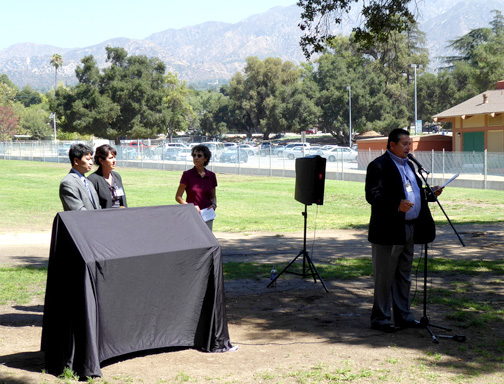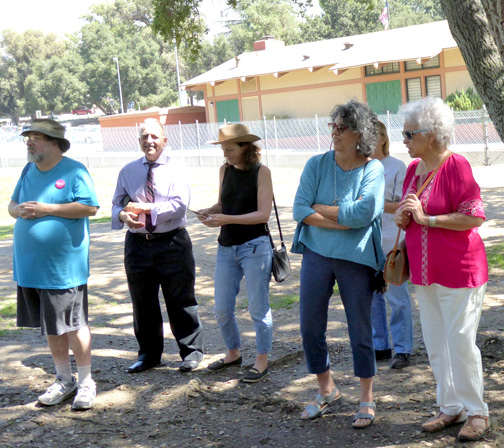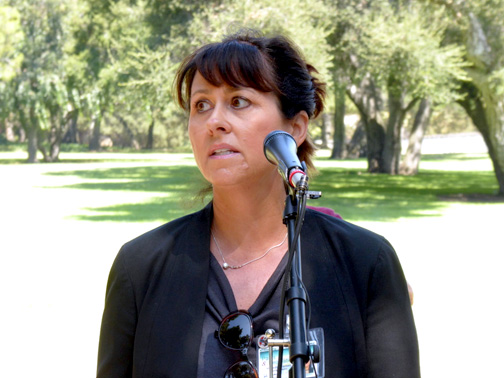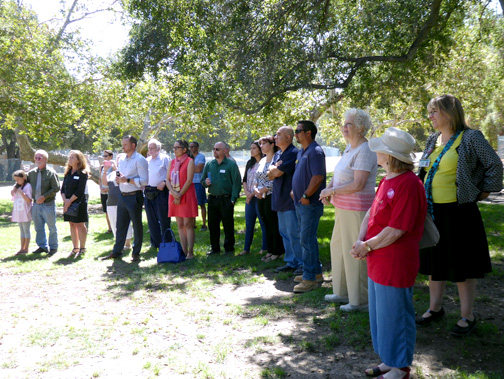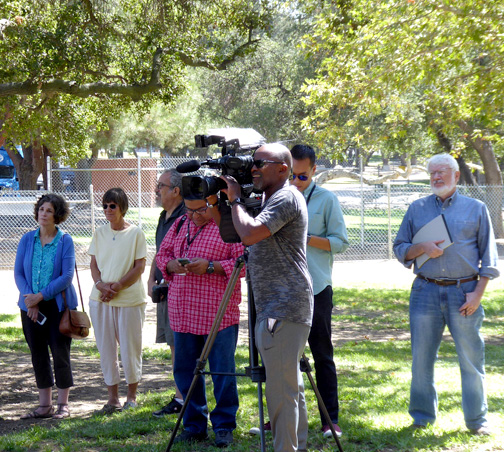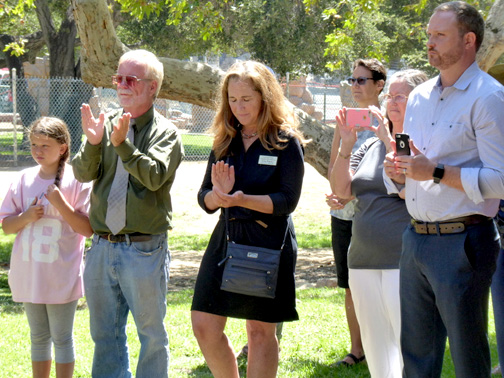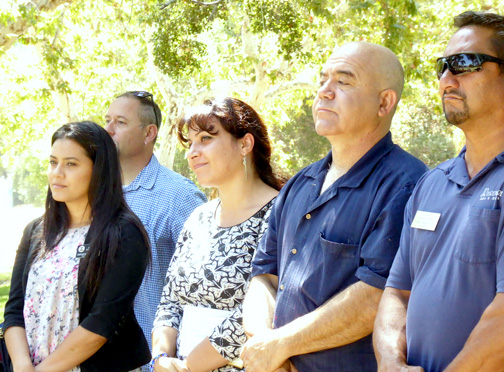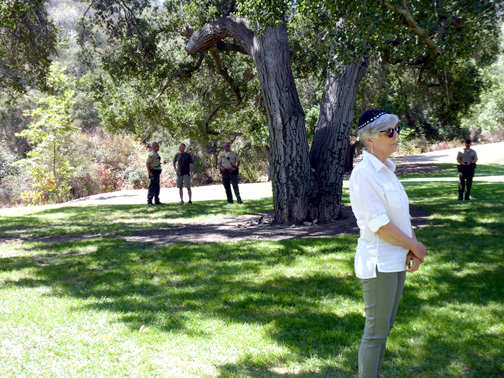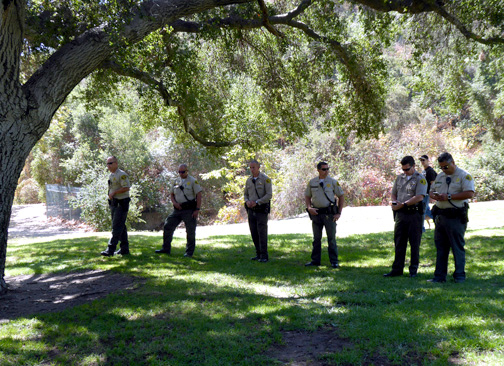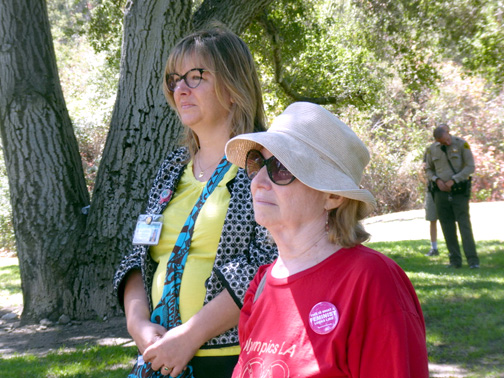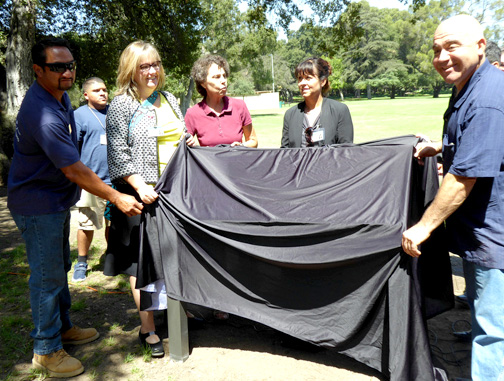
The newly unveiled marker at CV Park recounts the park’s history and was created with input from a variety of stakeholders.
By Julie BUTCHER
As the rest of the country shudders at the sight of neo-Nazis marching in Charlottesville, racial hatred, and anti-Semitism on full display, the communities of the Crescenta Valley celebrated understanding, dialog and tolerance instead. On Friday, people gathered to unveil a new interpretive marker in Crescenta Valley Park that honors the past – the good and the bad.
In early February 2016, a large wooden sign sprouted up at the intersection of Dunsmore and Honolulu avenues, announcing the entrance to the park, naming it Hindenburg Park. Written in large Gothic German font, the sign said, “Willkommen zum,” – “welcome” in German, and it caused an immediate reaction in the community.
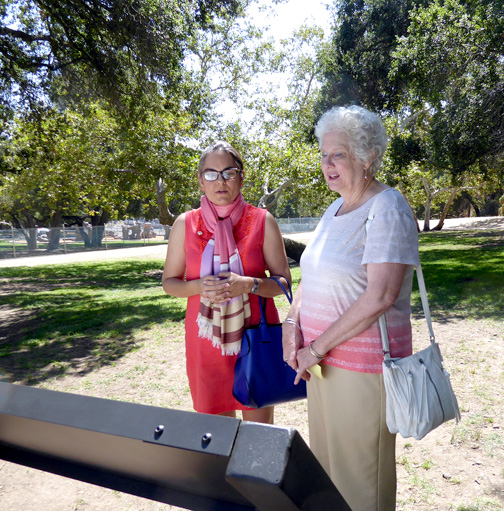
La Crescenta-Montrose resident Carol Dorbacopoulos remembers the day clearly: “When I first saw it, I thought it was a movie prop,” she recalled. “I put my groceries away and drove back, saw that it was permanent, saw the Parks & Rec logo. Now, I know the history of this park. All you’ve got to do is Google Hindenburg Park and it’s not too long before you’re watching footage of Nazi rallies. And I said ‘Oh, hell, no!’”
What followed was weeks of calls, letters and an online petition signed by more than 300 initiated by Glendale Community College professor emeritus and former community college board member Mona Field. The Los Angeles County Commission on Human Relations convened a public meeting at the Sparr Heights Community Center on April 7 that more than 120 people attended; 47 made public comments. On May 2, the Commission voted to take down the sign and to create an ad hoc task force to design a new sign to tell the whole story.
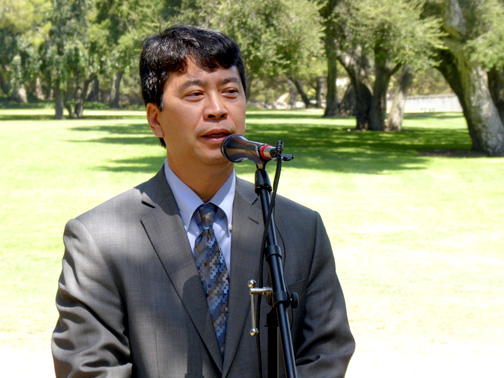
The sign was removed on May 4, 2016.
“The Commission and the County took the issue seriously and worked hard to be objective,” Jason Moss, executive director of the Jewish Federation of the Greater San Gabriel and Pomona Valleys, recounted. “The ad hoc committee delved deep into the language with the help of a quality mediator and the positive results show that we can come together through respectful dialog.”
At the unveiling of the new sign on Friday, Field thanked “the La Crescenta-Montrose community, Dorbacopoulos, the Jewish community, Unitarian ministers, rabbis, people of good will of all background who signed petitions, spoke at hearings, made phone calls.” She specifically recognized the members of the task force who worked to create the new interpretive marker for the park.
“The truth of our history is important – remembering the good as well as the bad,” Field addressed the small crowd assembled in the park. “There is no neutral position when it comes to Nazism, anti-Semitism, racism. These are bad ideologies that create hatred and violence. They are to be resisted in every way, including our small effort to tell the whole story of what happened when this was called Hindenburg Park.”
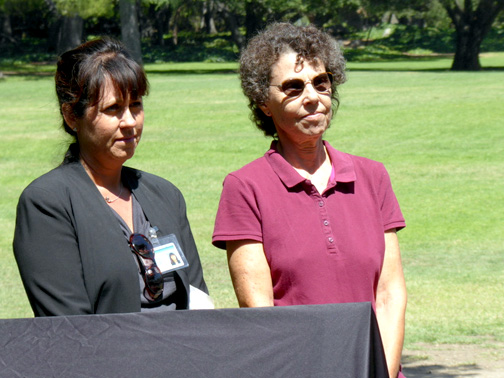
“As the sign now says,” she added, “Although the events of the 20th century may seem distant, there continues to be a need to guard against all forms of hatred, racism, and totalitarian ideologies of all types. The American ideals of justice and equal opportunity still require our vigilant support.”
“This is such a good thing,” Robert Lurye of Silverlake commented about the event. “As a gay man, as a Jewish man, I see the name Hindenburg as empowering Hitler. I see it as hate. I’m so glad to be here with my partner to see this happen.”
Human Relations Commission Executive Director Robin Toma commended the process in his comments.
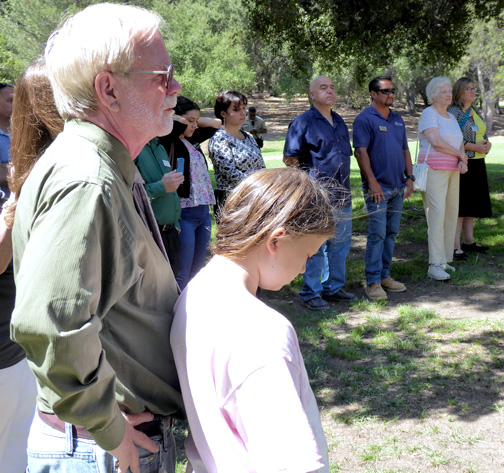
“This is an example of how to do it right. In this timely moment, we honor the process – people came together, even with emotions running high, and they respected each other and worked through their differences and disagreements. We can’t erase history, but we can ease some of its pain.”
Mike Morgan of the Historical Society of the Crescenta Valley attended with his granddaughter, Haven Kingsford.
“I married Haven’s grandmother in this park in 1987, right over there,” Morgan pointed to the area just west of the dog park. “We can’t change history, not the good or the bad. If not for the Germans buying this land back when they did, it wouldn’t be part of the park today. Parks are for everyone and the community coming together to design the new sign is a very good thing.”
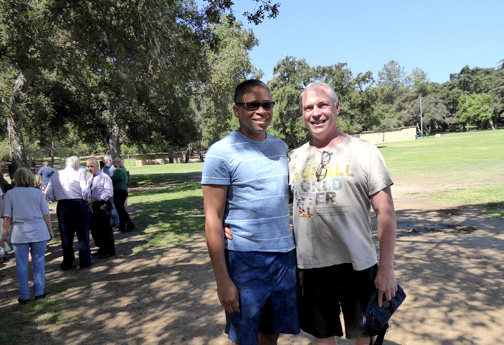
Privately funded by the Tri-Centennial Foundation, a German heritage organization, chair Hans Eberhard has consistently said that the sign was meant to be a symbol of the positive cultural and artistic contributions of German-Americans to the area.
The German American League first acquired the land west of Dunsmore in the 1920s as a place for Germans to gather for social, cultural and holiday events. The first Oktoberfest held in the U.S. was held in Hindenburg Park in 1958. The County bought the area in the late 1950s and folded it into Crescenta Valley Community Regional Park. In 1992, the designated section was dedicated as Hindenburg Park and a small is still in place to denote the commemoration.
In the late 1930s, there were rallies organized at the park by the German-American Bund, an American Nazi organization. Hindenburg Park also housed Camp Sutter, a boys’ camp modeled after the “Hitler Youth” in Germany.
Paul Von Hindenburg was a German stateman and military hero of World War I. He served as Germany’s president from 1925 until his death in 1934. In 1933, he appointed Adolph Hitler as the country’s chancellor.
Dorbacopoulos took one last look at the new sign and smiled.
“Never forget,” she said. “Never forget. Never again. Or it will happen again.”

